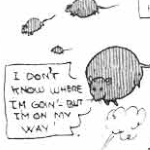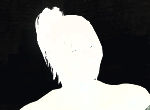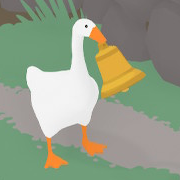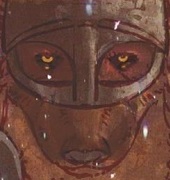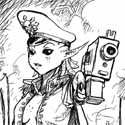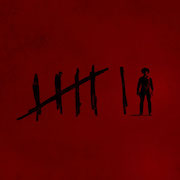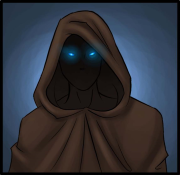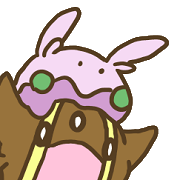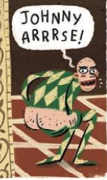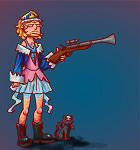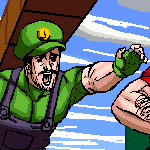|
Xiahou Dun posted:Wait they don't have the printing press? I actually don't know if they do or not - if they do, the Brotherhood hand-copies as an act of study and meditation. (I mean, they do that either way, but it's fairly reasonable to assume they'd do so even if the press existed, these are guys who barely acknowledge the concept of beds.)
|
|
|
|

|
| # ? Apr 26, 2024 22:19 |
|
Yeah that makes sense.
|
|
|
|
They probably have woodblock printing in the setting but not movable type. So anything that wasn't an important document that needs ten thousand copies or whatever still has to be copied by hand. One of the alternate 4E settings, Iron Rokugan, featured movable type as an instance of modernity encroaching on a conservative society. Edit: Historically one of the biggest obstacles to movable type was the giant library of characters you needed for Chinese hanzi and its successors, both for actually printing and as an obstacle to learning the writing system in the first place. NGDBSS fucked around with this message at 20:28 on Feb 22, 2019 |
|
|
|
NGDBSS posted:They probably have woodblock printing in the setting but not movable type. So anything that wasn't an important document that needs ten thousand copies or whatever still has to be copied by hand. One of the alternate 4E settings, Iron Rokugan, featured movable type as an instance of modernity encroaching on a conservative society. China invented the printing press around 200 BCE and had it 100% down by the 8th century CE. They invented movable type and then discarded it cause yeah it's kind of a bitch with how characters work. They'd get a calligrapher to do each page and then turn that into something printable. Old Chinese people printed a LOT of stuff, not just big important government documents. Like, there's a poo poo ton of ancient written materials that are basically the equivalent of bodice-ripper novels. (I work with ancient Chinese texts for a living ; fuckers printed EVERYTHING.) Also learning the writing system is actually really easy, assuming you already know Chinese. It's just designed to write, you know, Chinese, so if you're learning it at the same time you're learning the spoken language it's hard. It's hard to get firm numbers, but China historically had a positively ridiculous literacy rate compared to, say, Europe for most of its existence.
|
|
|
|
Emerald Empire: The Monk with the Dragon Tattoo The High House of Light is located on the side of a mountain, deep in the Togashi provinces of the Dragon. It looks unreachable from a distance, and those that wish to reach it and join the Togashi Order must find and climb the thousand steps to reach it, through snow and ice and spiritual dangers. Those who wish only to request the wisdom of Togashi Yokuni or his followers can request a guide at the small hamlet at the mountain’s foot, though whether they actually get one or not depends on the whim of the monk they talk to. Togashi Yokuni is both Dragon Champion and head monk of the Togashi Order, and is often found meditating in or around the monastery, always in full ceremonial armor and helmet. His answers to questions are much more cryptic than those of most monks. Other notable inhabitants include Togashi Gaijutsu, a blind tattoo master. His body and head are covered in images that seem to shift and change on his flesh. He tattoos the ise zumi, as the Togashi monks are known, in courtyard of his workshop. He never works for money and cannot be bought. He occasionally receives mystic visions, which he freely describes to anyone who cares to ask. Togashi Umu lives in the hamlet at the mountain base, and while she is not tattooed, she otherwise dresses and acts like she is one of the ise zumi. She can often be found chopping wood outside her hut or digging in the garden, and she seems to enjoy physical labor. She doesn’t speak much, but will answer questions asked very directly, usually with a simple ‘yes’ or ‘no’ and no further explanation. The Togashi monks pursue Enlightenment by thought, meditation and study of the Tao – and any other methods they consider to be appropriate. They train mind and body, for mastering both is required to become ise zumi. The monastery’s interior is a maze of cold, bare rooms without decoration or furniture, easy for visitors to get lost in. Whatever mysterious force makes the stairs to the monastery so difficult to find seems to guide the monks through the interior while confounding anyone else. What is actually contained within the High House of Light past the many shrines on its upper levels is known only to the monks. (I am also going to note here that at least in past editions, Togashi Yokuni was the latest alias of the still-living Kami Togashi. It is unclear if this remains the case, but likely.) Rumors of the High House posted:
Our NPC is Chikako, Initiate Monk. She is a girl devoted to the Tao and determined to enter the High House. Chikako is her actual, given name, but she refuses to use her family name at all. She feels called to the monastery and is certain she is going to join it. She was raised as a samurai and has some knowledge of both court and combat, and while she is small and quiet, she is fast and strong-willed. Despite her youth, she has a noticeable aura of spirituality, and fate seems to bend in her favor. She speaks with the wisdom and confidence of someone far more experienced than she actually is, and she isn’t afraid to fight for her beliefs. She is a bit of a fanatic, however. The adventure seed reveals her family name: She is Zurui Chikako, the young daughter of a local lord. Her father has no idea where she is and believes her kidnapped, and her mother wants the PCs to help. Lord Zurui has dismissed the rumors that a girl matching his daughter’s description has been seen near the High House of Light. When the PCs go check it out, Togashi Umu appears unexpectedly to question them. If Umu thinks the PCs are genuinely concerned for Chikako’s safety, they’ll find a path after speaking to her. Otherwise, they will become lost in the mountains for a time, facing large ravines, crumbling cliffs, predators and even dangerous spirits before they reach the path. Either way, the path will lead them to a hamlet, where Umu is waiting for them. If they ask Umu’s aid directly, she (though for some reason the seed thinks she’s male now) will reveal that Chikako has entered the monastery, and will lead them there. At the monastery, the monks make no efforts to hide Chikako, but the monastery itself is a maze, difficult to navigate without a guide. Chikako, when found, is shaving her head, having been accepted into the Togashi Order. She explains that her family would never have allowed her to go, so she snuck out, and she wants the PCs to tell her parents that she’s where she’s meant to be. The PCs must now decide whether to respect the girl’s wishes (and face a possibly angry lord) or try to convince her to return to her old life. The Silent Ones Monastery is devoted to Tsugumu, Fortune of Secrets, and is hidden near the City of Lies. Scorpions whose secrets weigh on them go there to unburden their souls, bringing messages or journals containing their secrets in order to feel themselves less isolated. They also often bring donations in thanks to the monastery for keeping these secrets safe (and possibly burning them as offerings). The monastery is a small, walled complex built into a hillside. It is easily missed, and while the monks are still part of the Brotherhood, they practice some rather unique traditions. Most of them wear black, for example, including a black cloth worn over the mouth. The head monk is easily spotted because of his scarlet robes to distinguish himself from the others. He is a lean man with an unflinching gaze that can discomfit even the bravest bushi, and he loves learning secrets. He has a way of getting people to talk to him and reveal their hidden knowledge without ever saying a word. The actual historical details behind the founding of the Silent Ones Monastery are deliberately removed from all records. Some say that even the engineers and builders involved were brought to abrupt deaths after building the place, to ensure its structure remained secret. Rumors of the Silent Ones posted:
Outsiders often find themselves lost and confused when visiting the monastery. Rather than tranquility, the place has an atmosphere of unease and anxiety. This is not caused by any spiritual power, but rather the techniques used in constructing the monastery and the actions the monks take to conceal and mislead people. The interior seems much larger than the outside, due to concealed passages and hidden rooms, with entire stories hidden underground or between floors, and many puzzles and traps are spread throughout the place to confuse and disorient. All of the statues of Tsugumu are identical, so many rooms look exactly like the others. Any of the rooms the monks use for sleep, training or eating are hidden, isolating visitors, who wait in small chambers with thick tatami mats and shoji screens in the colors of the Scorpion. Eventually, a single monk will come and lead them to a statue, where they may confess their secrets. Our NPC is Aotara Akira, “Pilgrim.” Akira acts like and claims to be a noble courtier. He wears the red and black of the Scorpion, never answers a question the same way twice and often makes people suspicious with both his desire to avoid attention and his general sliminess. He changes out his mask more often than most people change clothes, and if anyone questions him too closely he may attempt to poison their drinks or even brush poison onto their skin. He has a wakizashi but no katana, and many knives hidden in his robes. His true aim is to reach the Silent Ones Monastery, become a monk and escape justice for his many crimes, and he is a kleptomaniac. He literally cannot resist any chance he sees to steal things. Plains Wind Monastery is a practical place, devoted to Kuroshin, Fortune of Agriculture. It is focused on helping the local community, and the monks work alongside the local peasants in the fields and rice paddies. The monks also raise healing herbs, and they store as much surplus of all crops as possible, in order to supply Unicorn forces with food and healing plants when required. The monks also learn how to fight with farming tools. When the Ki-Rin returned to Rokugan as the Unicorn and eventually gained some land, they made a small shrine to Kuroshin in the hopes that the Fortune would bless their farmlands. Adjusting to farming was not easy for the nomadic clan, and so they decided to build a monastery around the shrine so that the monks could ensure the Fortune’s blessing. The monastery was made hastily, but was one of the earliest steps of the Unicorn in trying to befriend the Brotherhood of Shinsei. The monastery is a large wooden complex full of storage barns, an infirmary, a barracks for the monks and an open-air training area. The buildings focus on the shrine at the center, which is in the middle of a large garden of exotic herbs. The monastery sits between a peasant town and their fields, so peasants pass through the grounds daily. Plains Wind Rumors posted:
Dai, Fortunist Monk, is our NPC. If the place had a head monk at all, it’d be her. She is descended from the original monk that suggested the Unicorn build the shrine in the first place, and she is the community’s leader. She treats the sick using recipes passed down from the Unicorn since the days outside of Rokugan, and has learned to grow foreign plants despite the different soil. The herb garden around the shrine is her personal project. If anyone tries to fake illness, she sees through it easily but rarely says anything, instead “treating” them with unpleasant but harmless herbs. If anyone tries to force information from her, the entire community would fight for her, but she’s generally generous and cooperative if approached politely. Adventure seed: A Lion daimyo wants to know the truth of the Plains Wind Monastery and the rumors surrounding it, and he’d like someone to pose as a peasant and go uncover its secrets. He considers the job to be beneath an honorable samurai in his service, so he’s offering it to outsiders – the PCs. He tells them that the monks offer food and shelter to the sick, and hints that they might try faking illness. As they explore the place, the PCs could find any number of secrets for the daimyo – poisonous plants in the herb garden, plants none of them can recognize at all, stores of food for Unicorn military forces, an infirmary prepared to treat battle wounds. It’s when they try to leave that the PCs learn they’ve been watched the entire time. Dai prevents them from leaving so she can speak to them. She doesn’t appreciate lies, and does have herbs that will induce truthfulness, if the PCs resist talking to her hard. If they negotiate, she explains that she doesn’t mind the Lion knowing some things – she wants them to know the Unicorn are strong, and even suggests exaggerating the Unicorn position. If the PCs attempt to fight their way out, they will find that not only are the monks prepared to fight back, so are the farmers, in defiance of Rokugani tradition. Next time: The Wild Places
|
|
|
|
 Thus Spoke Aroaleta posted:... and king upon king sent his people to die, in wave upon wave over rolling plains; men and women on whose broken hulls, an imposing realm was built. Such was the foundation of Symbaroum: built with flesh and blood. THE PROMISED LAND  not many of the pics are going to be super appropriate so there's just going to be cool scenery stuff The book closes with a pre-written adventure module, designed to introduce people to the setting and system. It does a pretty good job of it, covering a lot of ground and setting up for further adventures with plot hooks (that all get covered in the extensive campaign material released later). There's a few pregenerated characters to draw from. I'd recommenced not giving them to player characters, since they're not optimized, but their personalities are good to crib. The ones they recommend are all from the south, but there's also a few barbarians and some monster-race people to cover those bases. Those are all designed to not be in a position to know much. When we did the adventure, we made our own characters who were less ignorant in general, which made a few things work differently. The adventure starts far to the south of the forest, in the mountains of Old Alberetor, where the Ambrians came from. Everyone is situated near each other, sitting around a fire during a harsh winter night. Around them are a mess of tents and wagons, with throngs of stoic refugees around them. Although the backstories of individuals have little set in stone, the land behind them is blasted by apocalyptic war with necromancers two decades ago, and the column of refugees are likely the last who could ever make it out. It's a good setup for imbuing some degree of competency and history: either you're a veteran of two decades of war against the dead, have been adventuring far away from home or at the very least traveling hard. quote:Player characters who have been raised in some part of Alberetor or have been there some time all carry dark and haunting memories from the journey to the camp. South of the camp the ground has still vigor enough to nourish vegetation, but the crops soon to be harvested are not what they once were. The fields are sparsely vegetated by pale stalks with shrunken ears of grain; the orchards that used to be full of apples, lemons and sweet plums are all but naked; and scrawny cattle can be seen everywhere, grazing in the all but naked fields, roaming wild after being left adrift by their previous owners and caretakers.The ones who come from a place further south or out east have witnessed even darker scenes. In those places the soil is blackened and completely lifeless, often transformed into dusty deserts incapable of absorbing water from either rains or rivers. Abandoned cities, deserted residencies and castles, ghostly farms whose livestock enclosures are occupied by nothing other than carcasses – Alberetor is dead and all but gone. All that is left is what the people of Queen Korinthia carry with them on the journey over the mountains. As well as the Pcs around the fire, there's a coachman named Telk, flanked with a couple barbarian pathfinders named Belun and Ludo. Telk is a curious and talkative guy, and gives an opportunity to get people talking about their characters. We all love doing that poo poo, admit it. There's not much else to do than talk at this point, since the winter's so bad it's too dangerous to travel, even though the snow will block the mountain passes soon. After the chatting's over, Telk's mate Keler whispers something in his ear, and Telk gets excited, leading the players over to a still-rich man named Argasto. He's planning on making the trip, and is filling his few remaining spots with whoever is going to improve his chances. Convenient for the players. He gets them to prove their merit with a quick combat to first blood against his current guards or similar display of competence. If they lose, they get put on anyway for a good showing and because it'd be a very stupid adventure otherwise. After a short timeskip of caravan travel in surprisingly good sun, everyone is thrown back into playing with screaming about a thief. One of the people on the adventure and a possible pregen, an apprentice wizard named Bartolom, had a magical artifact called a Sun-Stone stolen from him. This is bad news, not only for him: the sunstone has fire-magic powers in case of emergency, and it's the only reason the trip could get made. It's not so much a mystery as a way to learn basic problem solving. Almost any investigation at all tells you Keler did it and he's traceable to a ruined tower with a vigilant test or two. Aside from a bear trap he's easy to take out. Keler starts blustering about how someone called Mal-Rogan is coming, in a clever literary flourish known as Foreshadowing, and the Pcs end up with the deciding vote on what to do with the thief (he's pretty hosed unless you totally forgive him, and he's too craven for that to be a good idea)  the game doesn't need a gridmap as much as D&D but it helps, and they supply a few for key scenes. We haven't really used them and we've managed alright thanks to less AOE and strict range rules than other games Mal-Rogan turns up if the players hang around the tower at all, along with a crew of fellow robbers. He's a pretty scary undead nobleman-turned bandit with his severed hand hanging around his neck and veins full of black pus. The fight can be very tough: Mal-Rogan hits hard and has a nasty magic curse ability, along with a bandit with a crossbow for each PC, but with the tower on your side you'll probably be OK. Mal-Rogan's severed hand is an artifact with a couple of nice powers, but he'll always come back from the dead while it's around, so it's probably not worth it. The Real Symbaroum starts with the adventure's final leg. The players are all out gathering firewood, along with the two barbarian pathfinders mentioned before, and a Black Cloak (witch-hunter) called Lestra, who wasn't mentioned. I'm sure there's a casting list somewhere but I can't find it, so maybe it's just assuming you aren't hobnobbing with the other wagons. Suddenly there's a great howling and a big wolf with a pack of smaller Jakaars (basically forest Jackals) behind, and it charges towards the barbarians. It's weaker than you'd expect, and goes down easily against all the numbers. Unfortunately, the wolf's corpse changes into that of a young, battered elf woman with an iron bracelet on her arm. Anyone with any knowledge about the forest recognises this is a warrior of the Iron Pact. Now you've got a body to dispose of, and that's the least of your worries. Everyone who has any sense at all gets nervous, especially the barbarians. The southerners are less bothered, with Lestra musing about why and Bartolom making patronising remarks about witchcraft. There's an intermediary scene of the weather getting really bad and the wagons get circled. Somebody with Witchsight can tell that it's magical in origin, and observers may hear singing in the distance. Generally if somebody is singing in symbaroum, it's not good for you, so this is a good learning experience. That morning, two more elves appear at the camp and make a proclamation. The boss Elf posted:We want the ones called Belun and Ludo. They have violated the treaties; they have tunneled too deep into the soil of old Davokar. They are blight-stricken and must be purged. The two elves whisper something to each other in elvish, and if anyone can understand the language, there's a translation where they argue about whether to just kill everyone, but the relatively peaceful option wins. Maybe the Iron Pact is as fractured as everything else. They end up with an ultimatum: Give them the barbarian pathfinders by sundown, and everything will go peacefully. The only objectors are the barbarians, obviously, but Lestra says the Church has a fortress-temple nearby that researches corruption, and says to dump them there instead. The Pcs have the deciding votes.  The Monastery of the Twilight Friars is in the nearby mountains, far enough from Ambria that it poses no threat. Here, experiments and dissections are done to discover the truth about corruption and abominations by very dedicated priests. It's not a terrible idea to take them there, although I wouldn't hope for them to be cured If you manage to get Belun and Ludo to spill the beans, they reveal their little story. Before getting on the caravan, they were hired on a treasure-hunting expedition by a suspicious man named Gorak. They should have declined after hearing the name, it's got too many harsh consonants. They found the tomb of some barbarian lord with a copper crown merged into its skull. He remembered Gorak passing it around the campfire for everyone to play with. After living like kings off the haul, members of the expedition started disappearing or changing. They got worried about being watched and fled south. A fairly standard story in Ambria. This wasn't a hard choice for our group at the table. We had a couple barbarians, including a witch, and they know the score well enough with this poo poo. We basically just went "you broke the taboos real bad. Ya hosed up and you're probably going to turn into a monster. Like half our culture is built on not doing the thing you just did." This might be more complicated with some Theurge Pcs, but really the elves are probably right. Symbaroum is one of the few settings where Elves being arrogant Dickheads works: They have a good reason to be and mix in the 'woe is me' stuff at a reasonable level. Just give them the poor fucks. The adventure splits for the final encounter based on whether you side with the elves or not. If you plan to hand over the barbarians, they panic and try to fight back, which is quickly interrupted by a monstrosity bursting out of Belun's skin: An abomination with bare muscle, knives of bone for fingers and bony spikes growing from its skull. It's a very nasty attacker that just goes berserk immediately tries to rip everything apart. If it gets some hits in, it can very easily kill a character, but it's outnumbered and won't last too long. If you go up against the elves instead, one of them is a very mobile archer and the other turns into a bear. They'd gently caress you up but they only care about stopping the abominations. As a GM I'd angle for a three-way fight where Belun and Ludo turn midway through, although I think most people would side with the Elves. Once that's wrapped up, the storm dies down and the caravan travels onwards. Congratulations, get like 8 xp points. This introduction leads straight into the main adventure line, so you can touch the crown and go all crazy too. I'm not going to write up the index, so the book is over.  The perils of this journey are nothing compared to what is to come NEXT TIME: FINAL THOUGHTS
|
|
|
|
Libertad! posted:Hello everyone. Way back in late 2013 I wrote up a Fatal and Friends on Zak S' Vornheim product. I am no longer able to edit the original posts, but as the review is archived on the Inkless Pen site, I'm making a formal request for it to be taken down. Some major CW in the following links for many triggers: Protip: the best way to accomplish this is to PM me, not to post it here and hope I'll see it. (I am currently somewhere around January 16 in processing this thread, and I skip reading most non-writeup posts. Anyway, I've just unpublished it. (Also, it's not the "Inkless Pen" site. It's just the .com version of my handle.) Edit: if you don't have PMs, I am on Arivia's "SA Trad Games" discord and the #persona channel in IRC. inklesspen fucked around with this message at 00:16 on Feb 23, 2019 |
|
|
|
Xiahou Dun posted:It's hard to get firm numbers, but China historically had a positively ridiculous literacy rate compared to, say, Europe for most of its existence. Part of the difficulty though is determining what is considered a baseline for literacy in the two languages. Its extremely likely a lot more people understood common characters in dynastic china than could read basic things in feudal europe but its not necessarily that they had a grasp of enough to write or read much else. The differences in the two systems of writing are fascinating and have different outcomes for all sorts of technology and cultural moores. My favorite is china developed basically an offline auto suggest system they could translate to digital search systems that was created in order to speed up their use of moveable type in the 70s while letter systems auto suggest was basically a whole new world.
|
|
|
|
inklesspen posted:Protip: the best way to accomplish this is to PM me, not to post it here and hope I'll see it. (I am currently somewhere around January 16 in processing this thread, and I skip reading most non-writeup posts. Thank you. I sincerely appreciate you doing this. I appreciate the Edit tip as well; I'll keep that in mind in the future. Libertad! fucked around with this message at 10:57 on Feb 23, 2019 |
|
|
|
 A Hymn to the Leafy Deep, by Taubio posted:Shimmering curtains of golden rays,  FINAL THOUGHTS Symbaroum is an interesting example of an emergent European RPG style. There hasn't been much comment on it, but Europe has been producing a few interesting games with an approach like we saw in the 90s. I'm fascinated that games like Symbaroum or even Degenesis exist. Despite language barriers, they put out a really high production value series of books and succeed while American equivalents with larger IPs collapse on themselves. There's also publishers like Cubicle 7 or Modiphus that are quietly publishing lots of great stuff. Must be the social safety nets. I hope Brexit doesn't gently caress them up. Anyway, Symbaroum is a great example of this sort of AA rpg: influences from all over the place with a strong voice and a simple core system. It has its flaws, but it's definitely something I'd say to give a look at. I've grown to like the mechanics more as I play the game, but they definitely have issues. The main one everyone points to is the Armor and Damage stacking as an arms race because of how abilities and stats work. It screws over a lot of approaches and abilities that don't put out lots of raw damage, like multi-attack stuff or a lot of the spells. The stats are also out of whack, like how accuracy is almost always substituted out and everybody needs Resolute and probably Strength. There's little mechanical support for important out of combat stuff, such as journeys or diplomacy (most people say they want abilities for it, I'd say give me dedicated subsystems). There's also stuff I don't like, such as permanent corruption hurting casters bad long-term, but those are personal taste things. I like the relative flatness of the curve in some ways, but if you didn't realize how almost every melee fighter should take Iron Fist to adept, you're really not going to manage the real nastier stuff. The system's issues are definitely known by the devs, judging from how they try to patch it with later abilities. If you're going to play this, there's a house rule to replace Accuracy with (Strength +Quick)/2 for melee and (Vigilant+Quick)/2 for ranged that I'd consider mandatory. A lot of people convert the setting over to Shadow of the Demon Lord, which fits very well. Personally I think a hack of The One Ring would be amazing, and you could probably be fine with OSR stuff. Maybe even Burning Wheel if you're a maniac who can do custom lifepaths. I think there's going to be a d20 version at some point, but who cares.  I'm a sucker for a good rpg setting, and this is one I'd unequivocally recommend. It's thematically clear, has lots of meaningful conflict and it enables a lot of different narratives and adventures. Dark Fantasy is an underserved genre for RPGs: There are a lot of them, but most of them are either an absurd farce, a veneer over discrimination, or a way to justify cruelty and power-tripping GMs. A good work of dark fantasy is humanistic, and shows oppression and sorrow because it cares about the struggles of those who withstand it. Symbaroum, rare among rpgs, manages to have an air of mystery and melancholy, and gets closer than anything to that Dark Souls vibe of intruding on the fragments of a dead civilization. It's even got those item descriptions for artifacts. My time with the main adventure has been the best campaign I've played in (although a gm might have more quibbles). It's one of those campaigns with energy that goes beyond the table. Maybe it's just that I've started an office job, but I often feel my mind drift towards Davokar.  artwork of my Symbaroum character, Adela, that I commissioned at a con. Self indulgent of me, but so was this whole writeup, and I can't divide the two. I'm going to miss her when her saga ends, even though she really needs to get over herself
|
|
|
|
I should pick up Symbaroum sometime. Thanks for writing it up!
|
|
|
|
Free League Publishing is probably one of the better things that has happened on the Swedish RPG hobby because they've helped push out so many games to a wider audience abroad alongside Modiphius. Outside of Symbaroum they've also done translations for Coriolis – The Third Horizon, Mutant: Year Zero, Tales from the Loop and most recently Forbidden Lands. They also merged with Järnringen last year or so and started a crowdfunding campaign for Mutant: Hindenburg which is a sequel to both Year Zero and Heirs to the Apocalypse. Not to mention they're going to reprint the books for the latter system because they're pretty much a collectors item these days. Especially some of the latter books that barely got much of a printrun and can go for a lot money.
|
|
|
|
I'm playing a Symbaroum game right now and I agree with pretty much all of your conclusions. It's a fun game and has a unique atmosphere, but I don't know that I would go back for another campaign because of the janky mechanics.
|
|
|
|
Cooked Auto posted:Free League Publishing is probably one of the better things that has happened on the Swedish RPG hobby because they've helped push out so many games to a wider audience abroad alongside Modiphius. They're also doing Things From the Flood, a sequel/expansion to Tales From the Loop set in the 1990s.
|
|
|
|
Snorb posted:They're also doing Things From the Flood, a sequel/expansion to Tales From the Loop set in the 1990s. Ah yeah, I forgot that. Was mainly going off their website in this case. In that case you might as well also mention they're also doing a Lovecraft RPG tentatively called "The Great Old Ones" as part of a stretch goal for the Call of Cthulhu novel campaign.
|
|
|
|
JcDent posted:Cults: Neolibyans, pt. 2. Holler holler get dinar.
|
|
|
|
Snorb posted:They're also doing Things From the Flood, a sequel/expansion to Tales From the Loop set in the 1990s. Tangentially, I'm really hyped for the TV series.
|
|
|
|
Grenrow posted:I'm playing a Symbaroum game right now and I agree with pretty much all of your conclusions. It's a fun game and has a unique atmosphere, but I don't know that I would go back for another campaign because of the janky mechanics. I'm definitely more positive on the mechanics than when I started the writeup. I like the relative flatness of the curve in some ways (like how it keeps natural hazards always relevant), and it's all very simple. It just can't handle higher power levels since it can't scale the numbers in a reasonable way, so a lot of abilities and setups get screwed. Plus the stats are out of whack, with Resolute and Strength being super important to not getting destroyed by anything while Cunning and Discreet are only worthwhile for a couple niches. I think they're aware of the game's issues because of how they try to patch it with later abilities, but it needs something more extensive to really shine. Maybe doing the maths about armor and converting it to an equivalent amount of HP. At the very least, using a lot of enemies with abilities like Strangler or unorthodox attacks helps a lot. Wrestlepig fucked around with this message at 21:42 on Feb 23, 2019 |
|
|
|
Also, just for the record, in a few months to a year's time I'll probably have a homebrew to release, and I'd love it if someone from this thread would review it, giving it a good teardown if it warrants it.
|
|
|
|
 Dark Revelation is a d20 system RPG by Chris Constantin and Jason Cable Hall and edited by Joe Amon and published in 2014. Set in a twice post-apocalyptic world, it asks players to make their way in this hostile but still rebuilding landscape. It is available for free along with a host of expansion material and the developers blog Part 4: And the rest of the world, I guess Before we get to the rest of the world, there is a brief section discussing why the United States hasn’t regrouped. Apparently “two full-scale magical apocalypse wars” and “nearly a hundred years since the US collapsed” isn’t quite enough so the authors offer up some more reasons. The reasons like magic weather, dangerous creatures, and demons not wanting to join together keeping people separated is all well and good except not a few pages prior the book introduced a city where “thousands of artisans” flock to ply their trade alongside entertainment arenas known across the land*. Finally, time to explore the rest of the world. Most of the regions get a one or two sentence overview then a handful of points of interest with a sentence or two of description. On the plus side, a lot of this material is vastly more interesting than what was presented last time in North America and a goes much further to feel like the word is a hodge-podge of different things. On the downside, I’m not sure how players would be expected to ever visit or interact with any of these places given the settings assumptions. With all that in mind, I’m going to just cover what I think the most interesting of the 34 entries are:
I really wish Dark Revelations had done more here and gotten as weird as they could. Each one of these places should be totally unique from each other and provide hooks as to why a player might want to go there**. Neko Island is basically the only one that I think accomplishes all this. Players will be intrigued by free stuff showing up at ports all over the world so wherever they choose to play they'll know about it, the promise of untold riches makes the journey worth considering, and of course a mystery when they get there the game master can fill in and have the players investigate.  A cat not ready for the adventuring life With the rest of the world finished, we go back to North America to talk about the last faction that wasn’t with the rest of the factions in that section: The Democratic Peoples of the Potomac. The name is, somehow, not indicative of it being a tinpot dictatorship but it was until extremely recently one so it almost counts. This country is basically what the preppers would invent if they had to remake America, so its christianity mixed with nostradamus and other conspiracy ideas running a streamlined, smaller Presidency, the removal of jus soli birthright, and of course slavery. The DPP gets a multiple page write-up but there isn’t a real reason why. There is nothing in the game saying you have to be from the DPP or that the DPP even be in your game, and given that they’re racist, imperialist, religious founding-fathers as gods lunatics I can’t imagine a ton of players are going to be exactly eager to do anything with them but shoot on sight. In addition, one of their charts notes their military power in exact numbers which a) please don’t do this games and b) it has 2,000+ people listed as aircraft pilots. Let’s ignore the amount of logistics needed for this and instead focus on the fact that according to the timeline all of the last known warplanes were destroyed during second apocalypse. We then get some areas of note and I’m going to skip the population numbers because once again they upset the tone this game is going for. After that its a summary of how the DPP feels about the other factions which isn’t very helpful since almost all of them are “the DPP wants to conquer this to reunite the United States” or my favorite for the Candian factions, “this is too far away”.  Look at these dinosaurs, yearning to be cybernetically modified Closing out this section is the timeline I’ve already discussed and referenced a bunch. This is the only part of the setting that goes into actual details about anything and is frankly required reading to understand what is happening in this games setting. It’s also like I noted before, regularly in conflict with other sections of the book and itself, so how reliable it is will have to be up to your playgroup. Next time: The Apocalypse Didn’t Kill the Alignment Chart *The book states the population is roughly that of the Wild West era but for the part most Americans think of when they think “Wild West” would be anywhere between 3 million and 10 million people which isn’t anything to scoff at. **The Four Rules of Locations by Barudak:
Barudak fucked around with this message at 13:32 on Feb 24, 2019 |
|
|
|
Clearly, "Pilot" is a hereditary class. More on Cat Island, plz. Are the cats confirmed non-playable?
|
|
|
|
|
Honestly, the entirety of cat island is three sentences and it is never mentioned again in the book, so whatever is going on there is totally up to you. I'd go with tiny cat work force that doesn't understand that after two apocalypses nobody needs a shipment of fresh collectible keychains, but the games own suggestion is abandoned mech suits (for people? Could be for cats not clear) and trapped spirits. We'll get to the race section next time and sadly "Union-Shop Cat Factory Worker" is not one of them. Edit: You can't name your Japanese Cat Factory Worker Catsuhisa because I got dibs. Barudak fucked around with this message at 13:34 on Feb 24, 2019 |
|
|
Barudak posted:Honestly, the entirety of cat island is three sentences and it is never mentioned again in the book, so whatever is going on there is totally up to you. I'd go with tiny cat work force that doesn't understand that after two apocalypses nobody needs a shipment of fresh collectible keychains, but the games own suggestion is abandoned mech suits (for people? Could be for cats not clear) and trapped spirits.
|
|
|
|
|
Masaharu Morimeowto
|
|
|
|
Night10194 posted:That whole thing was the 'good' kind of randomization, I think. I have several players who love a bit of randomization in character generation because they like improv creative writing like that, and I bet they'd love that kind of system. For all their flaws and, uh, unusual opinions, I always found the Central Casting books a great way to come up with hooks for characters -- but I'd never use them straight because you'd end up with a bizarre, unplayable mess.
|
|
|
|
As someone who will never use this setting, I choose to imagine that they totally have 2,000+ airplane pilots but also no airplanes. They are all carefully trained to sit inside a cargo-cult cockpit made out of scavenged cardboard with painted on dials and make VRROOOOM noises with their mouths. All day. Every day.
|
|
|
|
Cults: Neolibyans, pt. 3 Degenesis Rebirth Primal Punk Chapter 3: Cults NEOLIBYANS Homestead When a Neolibyan reaches level 9, he can bui- wait, no. However rich, Neolibyans still have their home villages and clans to support. The whole bit is entirely hostile to the people that need that support, and shows that Neolibyans are, indeed, capitalist scum. quote:They equip the Scourgers, becoming an aspect of the great symbiotic relationship within the African people. The African people could be satisfied by this, but instead keep demanding more. Neolibyans: not yet the worst as Apocalyptics exist. A Drop of Bile In the home villages, Scourgers are seen as heroes that sacrifice themselves to Africa and Neolibyans as tricksters that get others to do their stuff. The book states that even the lowliest Socurger ranks higher than a Neolibyan. However, in Europe, the balance of power shifts and Neolibyans can enjoy wealth and opulence in their palaces stacked with riches and supplies. The Scourger power is weaker here because, ugh... I dunno, I guess they can't just shoot the resident Neolibyan if he refuses to supply them. Indentured Side section! When an African reaches 11 years of age, they can join a Neolibyan's entourage. At 17, they are presented to the auctioneer (the dude that does the New Years bidding marathon) and the Neolibyan host tell him about the applicant’s virtues. If the auctioneer embraces the youth, they become a Neolibyan. If they only shake hands, the kid remains  Nobody is really excited to visit Eastern Pollen. Big Game Hunting Side section! Some Neolibyans are fine with just being merchants that do merchant stuff. Others want blood, and thus they go on big game hunting trips in Europe. And while killing a mammoth or a Gendo is good, it's not good enough. That's why they hunt Aberrants. Same high caliber rifle (you leave you fancy presentation rifle at home), but the prey is kinda, sorta human now! Biokineticks are prized prey, as their bodies spit out bullets like Wolverine. In Foreign Lands Thus we approach the section that details what Cult does in which cultural region. It also states that trading emporiums maintain huge metal cargo ships. They take Scrappers and Scourgers to Europe and return with artifacts. Borca The Alps are expensive to cross, especially if you want to take a Surge Tank along. The Scrappers are unhappy about the Africans, too, and fight them in the ruins. Meanwhile, Chroniclers are spreading blood libel, because if your organization was started by Twitch streamers, it was started by racists. I have yet to see an explanation why Chroniclers hate the Africans so much. You can only theorize it is because they looted some servers or something. Anyway, the Judges don't really buy into that, but Chroniclers are their allies, so they don't permit the Neolibyans to loot the ruins. Meanwhile, the Clans are mistrustful of strangers while also more being more than happy to buy tea, spices and Franka Things are a lot more chill in Franka, as the place has already been looted and slave hunts are expensive in the swamps (and they're cheaper in Balkhan because). Trade only happens in coastal cities that Anabaptists and Spitalians have freed from Pheromancers. Some sailors go down river to buy bug-related stuff. Also, there's a hint of a plot hook: apparently the Bank lists twenty Surge tanks as missing in the swamps, and they're supposed to be “fully laden.” Pollen Wroclaw is the biggest trading center in Poland, but that's because the African big game hunters that travel there to bag some Biokineticks still want their luxury items, like tea, psychovore seeds and cut gems. Purgare Killing Psychokinetics is good fun, but the west is a blasted hellscape that ruins lungs and Surge Tank filters alike, so trading with the local clans is barely profitable. In the east, the war (between Anabaptists and Jehammedans) used to be driving the sale of Petro. However, the conflict is winding down and Neolibyans are already checking out possible new peacetime markets. Hybrispania Neolibyans actually believe that Hybris have already paid their due for their oil-stealing mercenary shenanigans. However, Scourgers disagree and the constant warfare makes trading beyond Al Andalus impossible. Also, we are reminded that Hybris make for lovely slaves, as they're a danger to any household (due to their hatred of Africans) and constantly lead rebellions in the oil fields. The best you can do is put them into the mines. Balkhan Voivodes love luxury goods, because of course they do. quote:In return, the Voivodes give them wood and slaves – and what slaves they are! Spitalians stand next to Hellvetics and Palers (bah!). Definitely better than stubborn Jehammedans and Balkhani. Yes, fanatical doctors and people who don't know life other than the military life make for better slaves than regular-rear end Balkhani. Must be that wiiild southerner blood!  Piracy Side section! Neolibyans claim control of the Med. The bank hires concession-less dudes to patrol the seas, which they do in the previously mentioned huge ships that are swarmed by Scourger torpedo boats. Allied cities can pay protection money to remain unmolested – and so their ships get passes that ensure they won't be boarded. Otherwise, a crew can end up as slaves in a jiffy. Next time: TOP 10 fattest cats in Africa
|
|
|
|
Alien Rope Burn posted:Rifts World Book 22: Free Quebec posted: Trash-loving-garbage. 
|
|
|
|
Emerald Empire: Where The Wild Things Are We are now in the wilderness chapter! There are vast stretches of land in the Emerald Empire where no human rules, where all there is is wilderness. These places aren’t even far away, even. The forests, isolated valleys, the mountains and the sea are all magnificent, beautiful wilderness – and dangerous. Samurai, of all the classes, are perhaps the most likely to have to pass through the wild lands. Ambushes, communion with forest spirits, artistic inspiration, ill-advised shortcuts – there’s all kinds of reasons. The eastern coastline has extensive beaches in white, gold and black sand, often with high cliffs. The coast is over a thousand miles long, ruled over by the Crab, Crane and Phoenix, and much of it does have fishing villages and harbors. Other parts, though, are too rocky or storm-prone for settlement by anyone save perhaps heimin hermits or small families looking to be left alone. These remote coastal people survive primarily on subsistence fishing, though they may be able to make a living quarrying sandstone, limestone, salt or chalk from the high cliffs, or even dive for pearls. They may also gather niche resources for trade, such as algae, shells or animal inks. These people are usually poor heimin, but shipwrecked sailors, samurai who have gone into exile and shugenja or priests seeking to commune with water kami or make a shrine are not unknown in these areas. Pirate groups often build secret harbors or lairs in the rough inlets, relying on the high seas and the coastal caves to hide their ships. The ningyo, an ancient, amphibious member of the Five Ancient Races, are rare, but these coastlines are where their underwater cities are most likely. Trolls also sometimes dwell in the coastal caves, usually endangering everyone nearby. The vast forests of the empire are both required and feared. They are very dangerous, full of poisonous plants and ravenous beasts, yet also provide healing plants, food, clothing and more. Perhaps their most dangerous quality, though, is their mysticism. Forests are notorious homes of spirits, close to the Spirit Realms. Ancient evils and irritable spirits lurk within them, leading people to ruin. Ogres, tengu and kansen all make their homes in the wild forests, far from man, and all are easily made violent if disturbed. Despite this, the risk can be worth it for those seeking to commune with powerful, ancient kami. The forests obviously provide much lumber for the Empire, with conifers in the north and deciduous trees, bamboo and fruit trees more common in the south. The island forests are similar to the southern ones, but with lighter woods, palms and many more kinds of fruit. Wood is a vital resource for all kinds of trades, so most forests do have small villages along their edges, dedicated to harvesting it. Forests can also provide berries, mushrooms, herbs, flowers, leaves, bark and insects for food and medical components, and hinin hunters and trappers hunt meat, fur and leather in the deep forests. Forest game may include deer, antelope, hare, wild pig, squirrel and pheasant. The forests are surrounded by superstition and legend. Folktales warn of all the dangers within, both to keep children away and as a metaphor for the untamed wild that lives within the human soul. Despite the fear and respect most Rokugani have for the forests, some do still live there. Some are exiles, others hermits that seek solitary life away from society. Shugenja may travel to or live within forests, building shrines deep within to appease local kami and spare the nearby villages their wrath. Some shugenja schools even train in the forests, teaching young shugenja to hear the spirits and make their scrolls from local wood. Bandits are also common in forests, as the people’s fear of their depths helps the bandits avoid detection. They make their homes in the trees or natural clearings, where they build small support villages. Ronin camps can also be found at the forest edges, seeking serenity while remaining close enough to villages to be hired to defend the locals from bandits, ogres and so on. Rokugan has three main mountain ranges – the Twilight Mountains of the Crab that holds back the Shadowlands, the Great Wall of the North that spreads across Unicorn, Dragon and Phoenix lands, and the Spine of the World, a thin but tall range that splits the empire in half, running through Unicorn lands to the border of the Scorpion and Lion, then on through the Crane. The mountains are dangerous to travel in without sufficient food or warm clothing, and the stone itself can be a danger. Rockslides can easily start avalanches without warning, and in the rainy seasons, the southern mountains suffer from mudslides. The Northern Wall has been known to shake and spew forth ash and magma, as the volcanic mountains seem to actively resist travelers. The higher you go in any range, the more sparse the wildlife – and the more dangerous, ranging from bears to mountain lions. Despite the dangers, the mountains are also rich in resources. Pine wood, river fish and some of the best and cleanest water in Rokugan are common there, and of course most mountain-dwellers are involved in mining. Basalt, granite and marble are all extracted from the mines, along with veins of iron, copper, silver, gold, platinum, sapphire, diamond and crystal. Jade can be found in mountain boulders in the foothills, and the caves are often home to rare minerals and gems. Rare flowers and other useful medicinal plants can also be found in the mountain passes and on their peaks. Most of the people that live in or near the mountains are miners or people who support or run the mining operations. Iron and jade are vital military resources, while others are massive economic benefits, after all. Mining towns could be nothing but a few heimin to large, permanent mining complexes with thousands of workers. Monks also are often found in the mountain monasteries, where they may meditate and attune to the world without distraction. Hermits, elders and exiles also often live in the mountains, preferring the natural dangers to those of life with humans. Abandoned ruins are also considered wild lands, including ancient cities, abandoned temples and lost shrines. Ruins are fairly rare, usually found deep in the forests or high in the mountains, or occasionally in other hard-to-reach and out-of-the-way places. While they tend to be collapsing, this is the least of their dangers, as many are home to ancient threats that predate the Day of Thunder. Ruins are often concentrated sources of spiritual power and mystic energies. When ruins are newly discovered, the clan that finds them is likely to keep them secret or even build a temple inside them or nearby to take advantage of them. Ruins are also a source of potentially lost or forbidden knowledge, and many shugenja have recovered ancient techniques by studying scrolls found deep in ancient temples. The lure of artifacts often draws in both bandits and explorers, hoping to find things that lead to wealth and glory. Because many ruins are still abandoned, a lone monk, shugenja or scholar might live in one for weeks at a time without being noticed. Caravans of priests, monks or shugenja sometimes visit certain ruins in pursuit of relics or legendary tales, to commune with specific kami or even to hunt for passages into Meido. These could be groups of a half dozen adventuring samurai or convoys of several hundred, depending on their funding, and they’ll tend to be guarded about their goals, though they will be courteous to fellow samurai. Ruins, whether underground, underwater or on the surface, may also be home to enclaves of the Ancient Races – the zokujin, tengu, trolls, ningyo or kitsu, who may all have dwelled in these places before they fell to ruin. Some may yet remain, guarding ancient secrets. The spirits and ancestors of the former inhabitants may also linger, unwilling or unable to pass on to Meido without help. Survival for samurai traveling in the wilds often requires compromises. It’s practically impossible while maintaining strict adherence to Bushido, after all. Samurai must not touch dead things, but doing so may become necessary. They may have to fish or hunt for food, or make leather for shelter or clothing if lost for an extended period. Because of their social restrictions on behavior and hygiene, samurai in the wilds must often choose between strict adherence to Bushido’s tenets and survival. Those traveling with lower castes can easily delegate such unclean duties, while those traveling alone can pragmatically forgo Bushido, as the Unicorn often do, without anyone witnessing their shame. The big problem is when groups of samurai travel together without heimin or hinin with them. Social pressure from their peers to follow Bushido makes it hard to do what it is required to survive, and often samurai in these conditions are forced into introspection about what they are willing to give up if it is needed to live. Next time: Five People You Meet In The rear end End Of Nowhere
|
|
|
|
Emerald Empire: You Make My Heart Sing While samurai are some of the most common travelers in the wilderness, they rarely remain there long. Most pass through it on their way to their next destination and little more, typically relying on caravans with a handful of heimin or hinin along to perform the tasks forbidden to samurai. They may spend days on horseback, talking to their fellow samurai or to monks or priests. Most tasks will focus on improving the odds of surviving the journey, usually by focusing on route safety, food and when to rest. Samurai also handle any threats and are expected to entertain any other samurai the caravan runs into. Of course, sometimes samurai go into exile. Many ronin spend their time in the wilderness, seeking a purpose. Some may even settle there to stand watch over some threat, protect a village or just have a place to stay. Their life is almost always a mix of quiet contemplation and desperate struggle to survive. Monks and, more rarely, priests may spend part of their lives in the wild lands, studying or communing with the elements, Fortunes or spirits while living off the land. Priests may travel to distant shrines or temples to train and meditate, sometimes for months or years. Monks may remain in seclusion in the wilderness for a very long time indeed, sometimes their entire lives, studying the Tao and seeking Enlightenment in solitude. Most monks practice self-denial or heavy labor as part of their study, and the dangers and discomforts of the wild are often considered to bring them closer to Enlightenment. The more punishing and grueling a task, especially to help others, the better. Other monks may travel the wilderness instead of settling in a specific place, seeking out lost teachings or spreading the wisdom of Shinsei to the people of the wilds. Priests and monks may well join up with a caravan, as above. If no one of higher status is present they will be expected to lead, but otherwise serve as advisors to the ranking samurai, often in the form of divinations or the reading of omens. Shugenja may even petition local kami for guidance, or seek the blessing of a Fortune to ease the journey. Most heimin work in villages and towns for mutual protection, but some farmers or miners must brave the wilds due to the nature of their labors. Others serve the traveling priests or samurai with menial labor or cooking. Even crafters, at least the eccentric ones, might decide to visit the wild lands for inspiration. The unique resources of the wilderness are sometimes worth taming the land and creating new villages or towns, though some are merely harvested by small groups of heimin laborers in camps too small to be considered proper villages. These camps are often seasonal, with the workers traveling to and from their hometowns, which may be weeks away, to man the camps for the harvesting season and then going home again. Typically, they try to focus on gathering enough to support their families for the off season and pay for the next trip out. Merchants also sometimes need to travel the wilderness. Caravans often must move along unprotected roads, and many merchants become experts in basic survival skills, though they usually bring food with them rather than hunt it. Their convoys form a tempting target for banditry, and without a protective escort, these merchants must rely on speed and secrecy to be safe. Other heimin travel as the staff of a samurai on business – armorers, attendants, cooks, laborers, wagon drivers and so on. They will also typically manage any hinin in a merchant or samurai caravan. Crafters are the least likely to seek the wilds, though some take sabbaticals to find inspiration in nature. Sometimes, an artisan may even develop secret techniques (and accompanying paranoia) that drive them live like a hermit, far from other people, to deal only with their most trusted apprentices and patrons. Hinin are easily the most common of the types of people that live in the wilderness, often in order to avoid the wrath of higher castes. A smaller number work as career criminals or bandits, forced into the wild lands to escape justice. Others work with traveling caravans, using their low status to perform the duties others cannot. The hinin of cities or towns may also be forced to go into the wilds at least some of the time to do their jobs, such as hunting, charcoal burning or waste disposal. Some of the hinin that live in the wilds do so for their own sake. Many of these are from villages ruled by cruel or callous lords who might execute them on a whim, and so they prefer the less personal dangers of the deep woods or the mountains to the more certain threat of death by samurai. These hinin can often manage a rather more comfortable life on the fringes than if they remained in the dangerous village they hail from. Criminal hinin also thrive in the wild lands, using them to evade capture and consequences. Con artists hide out there, and entire bandit villages can go undetected in the deep woods or hidden coves. Most bandit camps struggle to get enough basic necessities to survive, though, and the threat of the local wildlife is hard to deal with. Tales of supernatural danger may keep pursuers away, but many bandits also worry that these tales are true – ghosts and angry spirits are worse than magistrates. Larger camps may even go so far as to invent new stories and fabricate token evidence to make a safe place rather than risk finding one that’s actually haunted. Despite all this, the fact that hinin are the only ones who can easily perform certain survival tasks like skinning game or gutting fish means they’re invaluable for traveling groups. Further, on rare occasions a samurai may even bring a favored geisha with them, or other entertainers. While gaijin go virtually unseen for generations in civilized lands, there are a number of gaijin enclaves in the Northern Wall mountains and the Islands of Spice and Silk. The northern mountains are home to the gaijin tribes known as the Yobanjin, who dress in animal furs and are generally considered, like most gaijin, to be nonhuman beings that live outside the Celestial Order. However, their intricate and beautiful rugs are secretly favored by some Rokugani, especially the Unicorn, who tend to see them as just one more fascinating culture to learn about rather than as barbarians. The Islands of Spice and Silk are practically home to as many gaijin as Rokugani, most of them foreigners from places like the Ivory Kingdoms. They may live in their own island settlements or even alongside the Mantis. In the islands, they can freely trade and exchange ideas in most circumstances. The mountains of Rokugan were once bringers of catastrophic change, but now, they are mainly slumbering hulks, nearly impossible to cross without a pass. They define borders, both externally and internally, but they aren’t just barriers. The mountains keep many secrets, sheltering those that want to hide in their many valleys and caves and concealing vast amounts of precious mineral wealth. Scaling them can offer spiritual revelations, and it is impossible to know even a single mountain in one lifetime. While the mountains may slumber now, they still affect pretty much everything around them. The Spine of the World shreds the ocean winds, sending cool and moist air back down on the eastern coast and making it rich and fertile. The rains that flow off the mountains are the main source of water for the Lion plains, collected in cisterns. These rains also come through Crane lands, arguably making them too wet. The Uebe Marshes cover thousands of acres in the south, overflowing during storms. Mudslides threaten the farms near the mountains, and in Phoenix lands, the mountain rains come as freezing blizzards. While dryer, the western side of the Spine is not completely dehydrated. Unlike the east, the west retains its rigid, volcanic soil, with rivers of snowmelt flowing down towards Earthquake Fish Bay and the Shinomen Forest. The Scorpion and Crab rely on these waters to irrigate their fields, but not all of the waters that flow from the mountains are safe. Marshes of toxic gas seep through the rocks in parts of the mountains, and the Scorpion harvest the plants and venomous animals of these marshes for their toxins. The mineral wealth of the mountains fuel the war engines of the Clans, though few would admit it openly. The Dragon range of the Great Wall of the North is full of rich veins of ore, including the wealthy Serpent’s Tail Mine, which provides gold, iron and jade. Indeed, the mineral wealth of the Dragon is so great that most of their food comes from trading their ores for it, as their farmland is meager at best. There is one mineral the Dragon refuse to trade, though, far rarer than gold. Once per year on the summer solstice, the forge on Iron Mountain is full of chanting shugenja. They use clay blast furnaces known as tatara to layer iron sand with a mysterious substance. Most forges rely on charcoal made from white pine when forging steel, but the Dragon rely on something older and far more potent: a highly refined charcoal known as Dragon’s Blood, which is found in the Dragon mountains in air-tight volcanic chambers. When heated with iron, Dragon’s Blood creates a uniquely durable steel, perfect for blades, and this steel – but not the Dragon’s Blood that is required to make it – is one of the most valuable trade resources of the clan. In the Spine of the World, the Crane have discovered a massive iron vein of extreme purity. Legend has it that this extremely long vein was actually a weapon hurled from the sky by the Fortune Bishamon, and so the Crane refer to it as Celestial Ore. This ore, brought to Steel Crane Forge, requires only a few folds before it is rid of impurities and ready to become a sword, and the unique grain of the Kakita blades made from it includes beautiful whorls that resemble crashing waves. Not all clans are so lucky, however. While the Crab blades are some of the best, it’s because of tenacity, not rare ores. Most Rokugani iron, besides the Celestial Ore, is found in rusted bands that are contaminated by sulfur. Removing the impurities is tedious, and what doesn’t melt off in the tatara must be kneaded out by a series of folds of the metal. Like all master smiths, the Crabs at the Kaiu Forge make each blade from three types of steel – durable hagane for the edge, flexible shingane for the core, and kawagane as a skin between the two. Each requires a different preparation method, overseen by a specialist. Many Kaiu smiths dedicate their entire lives to one step of the forging process. And not all smiths work in steel, which lacks the beauty of copper or gold. The Blazing Forge of the Lion specializes in these two metals, and its products are widely considered the most beautiful metal goods in the Empire. Massive crucibles melt down the ore to rid impurities, then the metal is poured into ingot molds. The process of copper purification also leaves a beautiful, glass-like green slag that Lion artisans carve into decorative inlays that resemble gems. Next time: Dangers of the mountains.
|
|
|
|
Yare loving yare that's a lot of text.  There's no criticism nor any commentary. If you're summarizing, it's insufficient. The format is about as inviting as a brick, and I've read more interesting math textbooks. The book is currently in print, so you're not showcasing something rare, obscure, hard to get, or forgotten. Why are you doing this? What purpose does it serve? Who benefits from having read all that?
|
|
|
|
LatwPIAT posted:Yare loving yare that's a lot of text. I mean I'm enjoying it?
|
|
|
|
Here we loving go again.
|
|
|
|
Warhammer Fantasy Roleplay 2e: Old World Bestiary Magnificent Goddamn Catbird The Empire goddamn loves catbirds. I'm talking real catbirds, too, not the dumb wingless ones they put out in 8th edition when they wanted everyone to get some more monster models. The Empire is insistent that they've always loved Griffons and that they're an enduring symbol of the Empire and all and that's honestly not true in the least. No-one really cared much about Griffons beyond occasional experiments with using them as mounts until Emperor Magnus 200 years ago; he loved his war-Griffon and put it on everything, and now the Empire says it's been a traditional symbol of the Empire forever. They're scary as hell in battle; our first description of them is from one of our long-time merc commentators who was part of a losing flank until an Elector Count mounted on a Griffon showed up to turn the matter around. They can absolutely do that; the Griffon is often way more dangerous than the guy on their back. The other stuff from the Common View reminds us of another important bit about Griffons, and indeed most magical monsters in Hams. They're still animals. They mention they're hard to feed because their predatory instincts are very strong and they'll occasionally go after the stableboys (apparently only Emperor Karl Franz himself can safely feed his personal Griffon, Deathclaw, who is a Good Boy). Another commentator is a huntsman who says that for all the anthropomorphizing and romanticizing of these dumb catbirds, they're still catbirds, with bird brains; you go hunting for chicks to bring down for training, it's not that hard to distract the parents and steal their eggs. The Count of Ostermark goes over why the Empire loves Griffons as a war-mount for a general: It's really nice to be able to view the battle from the air. Even better when you can dive down into a fight that's going against your men (like the above incident with the merc) and personally rally them and make a big difference. A giant catbird slamming into an engaged unit hits like a wrecking ball, after all. Because of the association not only with Magnus the Pious, but also with the officers and nobles of the Empire, the Griffon is considered sacred in the Empire. This leads to another fun little aside from a scholar of Nuln, burned as a heretic for slandering the noble catbird; he makes the reasonable point that there's no goddamn way these things don't originate from mutation, same as almost any other magical beast. They're a stable mutation, as he says, and have been a long time, but he worries they're still originally from Chaos and might return to it. The Empire does not put up with anyone talking poo poo about its goddamn magnificent catbirds, though. I will always be fond of Griffons because they're silly but cool looking, and because I was in a game that centered around raising one, but they'd unbalance the hell out of a party if you ever actually got a full strength Griffon mount. They are mean as hell, with 50% WS, 4 attacks, 48 Wounds, and doing Damage 6 while causing Terror. You do not want Cedric the Griffon pointed at you, she will gently caress you up. I do really enjoy the consistent take that Hams monsters often still behave like wild (or partially domesticated) animals. Pegasi are considerably more chill, though still pretty formidable and awesome as mounts. Pegasi are another common flying mount for Imperial officers, but they're especially common for Bretonnian knights since they have extensive nesting grounds near Parravon. To the point that instead of just officers Brets could field units of flying cavalry. They're also thought of very positively by the people; the Common View on Griffons was all about how awe inspiring but extremely dangerous they were. Pegasi are instead spoken of as intelligent, taking to training well, and generally forming strong bonds with their rider. They don't kill nearly as well as a Griffon, but a big warhorse charging you at high speeds from the sky can still crush someone's skull. Still, people see Pegasi with unabashed wonder and a generally positive attitude, which is nice to see in Hams from time to time. We get a really interesting examination of Pegasi from a biologist who has cut a few dead ones open; she points out that they're very different from horses internally. They have bird-like, hollow bones that somehow stay strong and able to support their weight. They're omnivorous, often catching and eating fish or carrion. Even with the weight reduction from their internal structure, they shouldn't be able to fly; she theorized based on talking to a Light Wizard that Pegasi somehow catch the currents of the Winds of Magic for lift, which allows them to not only fly great distances but carry a fully armored knight without strain. There's also a really interesting talk from a Bretonnian horse breeder about how Pegasi born in the plains down below often refuse to learn to fly. He theorizes they're too smart to jump off high places unless they're actually born on a cliff, and if they don't learn as foals their wings will atrophy. Even in cases where that happens, you're still left with an unusually intelligent horse that takes well to training, and he observes that a Pegasus who never learns to fly is faster than a normal horse as it is. I think Pegasi have one of the most interesting Scholar's Eye sections of all the monsters. They're not quite 'sapient', but they're clever, and there are a bunch of neat bits of biology to read through. One of the big impressions you get from 2e WHFRP, but especially from this book, is that the people in the Old World are actively trying to figure out the world they live in. They're not content with 'magical flying horse bird', they want to know how it differs from a horse, why it behaves how it does, and how it manages to fly and carry so much weight. It's one of my favorite differences about Fantasy compared to the 'IGNORANCE IS STRENGTH' stuff you get all the time in 40k. Hippogriffs are the Horsebirds that the Bretonnians use as lordly mounts since they can't get at the Imperial Catbirds. They are inferior in all ways. This is mechanically true. You still don't want an angry Hippogriff pointed at you, though, and a Bretonnian peasant who manages to climb the mountains and catch a chick or egg for their Lord has a ticket to a better life. Similarly, a Knight Errant who does the same might get granted a title and lands on the spot. The Hippogriff vs. Pegasus debate is a big deal among Bretonnians, who argue endlessly over which one is the superior awesome magic flying mount. Imperials disdain the Hippogriff as a lovely offbrand Griffon (they are correct). Our burned Scholar friend is back to write about the Hippogriff and how it lives in a different mountain range than the Griffon (Griffons live in the eastern World's Edge Mountains, Hippogriffs in the Grey Mountains of the Bretonnian-Imperial border) and how whenever the two animals meet they try to kill one another. Of course, he also calls the Hippogriff a Chaos beast, but as they are not a national symbol of the modern Empire, it's much more likely he got in trouble for poo poo-talking the catbird. Hippogriffs will only ever accept a single rider, and that rider must have acquired the Hippogriff very young and hand-raised it from a chick. As you'll recall from Knights of the Grail, Hippogriffs tend to cause 'adventures' for their Knights, as they're prone to getting up to trouble, falling off things (when young), and trying to eat pets. They always seem to be hungry, and if you don't watch them that leads to trouble. As we see in the story of a Bret Knight who let his Hippogriff eat a young peasant in front of his Lord and Lady, and was ordered to put the creature to death for the affront. Hippogriffs are still dangerous as hell, make no mistake. They're just not quite up to the level of the true catbird. The Griffon has about 10 WS and 6 Wounds on the Hippogriff, but you still don't want to gently caress with something with Damage 6, 4 attacks, and 42 Wounds even if it's WS is 'only' 40. A Bretonnian Knight with a Virtue riding a Hippogriff is a huge shitwrecker that could potentially unbalance a whole campaign. Monstrous mounts are very, very strong. It doesn't change the fact that the Hippogriff still feels like a 'budget' Griffon, but I do like the detail that they inhabit totally different mountains and compete fiercely with one another when they meet. Next Time: Wyverns: The Dickbags of the Sky
|
|
|
|
Cults: Neolibyans, pt. 4 Degenesis Rebirth Primal Punk Chapter 3: Cults NEOLIBYANS  Nwabudike Morgan does Mad Max RANKS NEOLIBYANS  1. Apprentice If your kid is troublesome (i.e. wants to learn to read), you send him to the Neolibyans as soon as he's old enough. He'll do some menial tasks, become literate and maybe even learning arithmetics. 2. Scribe You're a scribe, you post “the gains and losses of at least one merchant route.” 3. Merchant Now we're in business: the 17-year-old has been recognized as a Neolibyan by the auctioneer. They can now start their enterprise with the wealth they have accumulated by... being a teenager scribe? This not the first time we find a 4a. Seafarer These are the explorers of the Cult, the ones that are bored with just doing deals and looking at Excel sheets the whole day. They go out, explore the seas and the rivers, and find new places for the capitalist Cult to exploit. 5a. Cartographer Cartographers are explorers extraordinaire, filling 5b. Great Hunter Tripol and its decadence wears down a man's soul. That's why he takes a big rifle and goes hunting! quote:He has escaped a world that was so protective and gaudy that it ate away his soul. Now, he feels the beast within again, stalking his mind, circling his reason. Grinning, he accepts it. Surrounded by Spore Beasts and Biokinetics, there is no predator more dangerous than himself here. I think I cut myself on the edge of that quote. 4b. Magnate They're “rich beyond reason” - just like any rich person – and plan to continue building their wealth. Also, their entourages are massive. 5c. Sheikh Sheikhs are so rich, they don't even need to try to become richer – it's just the natural course of events. They're said to be closest to the Libyan in wealth and influence. That's why they head the bank – and can ignore Scourgers and Anubites when it comes to politics. As such, they were able to invite Spitalians to Quabis and settle peace with the Voivodes. 5d. Raider A title usually used for the runts of the NPC litter in other games is reserved for one of the possible endings for the Magnate chain! Yes, when you're as rich as Croesus, what you really want to do is load a ship with Koms and Surge Tanks and go plunder Europe. 4c. Ambassador Ambassadors do diplomacy and negotiations. Magnates say they're dopes who won't ever get rich. Ambassadors reply that their wealth lies in their contacts. They probably didn't read the few parts of the chapter that claim that Neolibyans only worship the Dinar. 5e. Waziri You know what? Personal wealth sucks. As such, Waziris are advisers to Sheikhs and help run their empires. Their influence comes not from their stacks of gold, but from being employed by someone important. I bet players are chomping at the bit to become one of these guys. 5f. Consul I have already mentioned that changing trade route ownership yearly is probably not that great for infrastructure. That's why Bank of Commerce assigns Consuls to oversee the rule of settlements, no matter what dildo won the last concession race. Consuls take care of defense, logistics and diplomacy. Stereotypes posted:ANABAPTISTS: They are efficient workers and a counterpart to the goat herders. They take our weapons as long as they do not have to confess to it. The astute reader will notice that the stereotypes section is much shorter than it was for the previous cults. UKMENA  Culture: Africa Concept: The Adventurer Cult: Neolibyans (Seafarer) Ukmena is the daughter of a Magnate, so she had all the opulence she could ever want. Alas, she was unhappy until she decided to leave the past behind and set out on a ship. There, she gained renown and reputation. But she wants more and is preparing a ship to cross the Atlantic. EZENACHI  Culture: Africa Concept: The Traditionalist Cult: Neolibyans (Merchant) He used to be rich, at some point. But troubles started piling on, and eventually even his women left him and took the kids (the book remarks that the children were probably not even his, seeing how much time he spent at work). After briefly considering suicide, Ezenachi took a different path: he now joins entourages of wealthy Neolibyans as a scribe and works to set them on path to ruin and bankruptcy, jumping ship long before it sinks. His next target is Sheikh Darweshi. DARWESHI  Culture: Africa Concept: The Conqueror Cult: Neolibyans (Sheikh) Darweshi is rich and he wants everyone else to know it. However, he's been having trouble lately: Psychovores are closing in on his oil fields. And there are fluctuations in the accounting... In conclusion: Neolibyans are most likely the faces of the group, though the great game hunter and explorer paths have some other utility. That is, if you can squeeze in an African character into a game that's most likely going to be set in Europe and maybe even have a Chronicler in the group. And if you want to play the Capitalist. I dunno if that's just confirmation bias, but it seems that the book is going for African exoticism vibe, where Africans are more emotional and dynamic than Europeans, what with all the constant mentions of shouting, arguing and all that. It's almost ARABIAN NIIIGHTS up in here, even worse than what we've seen with the Balkhani. I wonder what they did with the Scourgers and Anubians! Next time:Avengers of the dark continent! JcDent fucked around with this message at 09:58 on Feb 26, 2019 |
|
|
|
Barudak posted:
Meow, meow, meow, sir
|
|
|
|
In at least one of the iterations of Warhammer there was a rule that should a rider die before the mount then said mount could react in a variety of ways from fleeing the battlefield to guarding their master's corpse. With Deathclaw you didn't have to roll as he would immediately devote himself to killing those who are responsible for killing Karl Franz.
|
|
|
|
Catbirbs were absolute loving monsters in the Total War: Warhammer video game too. A unit of Demigryph Knights packing halberds was ready to take on just about anything.
|
|
|
|
Oh, I also want to note that I appreciate Sybaorum's write up. It oozes atmosphere, and that is wicked sick. Too bad they didn't math it out right. E: One thing about the campaign you had and the "witnessing the last breath of a god" and all that: was that based on established material (as in a campaign or an adventure hook), or is it the achievement of a creative and good DM?
|
|
|
|

|
| # ? Apr 26, 2024 22:19 |
|
LatwPIAT posted:Yare loving yare that's a lot of text. I agree on the big blocks of text making for an intimidating reading and that the lack of judgement cast on the content in question serves as poor FnF fodder. Now, the Hams reviews might also be block's o'text, but they're funny as all hell (when I'm not in violent disagreement).
|
|
|

